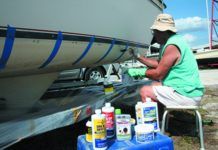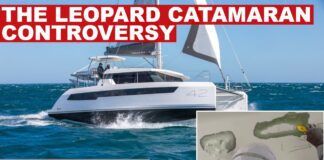Ronstan Recall
Ronstan, the Australian-based manufacturer of sailhandling equipment, has recalled its Series 60 and 75 All Purpose Stainless Steel Cheek Blocks with universal head post, distributed from October 29, ’04 to May 12, ’05. Company representatives explained that the head-post assembly in a small number of these products shipped during those dates may not have been welded to specification, and in some cases may not have been welded at all. This may result in the product failing to meet its load ratings. Ronstan representatives believe there’s a risk that using a defective product such as these could lead to personal injury, fatality and/or damage to property. The company is asking that boat owners who have purchased these products immediately return them for replacement. All freight and replacement costs will be covered by Ronstan. Customers within the U.S. are instructed to call 727/545-1911, or e-mail [email protected].
———-
Westerbeke Woes
I discovered a serious defect in Westerbeke’s Universal engine, which I wrote to the company about. The problem is the design of the camshaft. It is directly connected to the seawater pump. When the pump packing leaks, seawater corrodes the pump bearing and seizes the pump shaft, as it did aboard my Pearson Vanguard. This causes the connectors at the end of the cam shaft to break off, potentially burning up the engine because the water pump shaft is no longer driven. Instead of merely replacing the water pump, as with most engines, the engine must be pulled, head and manifold removed, and camshaft replaced. Clearly, this is a serious design flaw.
My engine, a Universal model M-25XPB, was installed by an excellent mechanic in 1999. It is just over six years old, has only 188 hours on it, and has been religiously run once each week, and has been serviced annually. When I notified my mechanic of the problem, he found out that there had been a recall, but apparently not a thorough one. I never received a notice of this from Westerbeke nor the dealer, or I would have taken immediate steps to correct it.
I spent a day and a half working on the engine to discover the problem and disconnecting the engine from the boat. It will cost $800 to have the engine pulled, and $1,150 for it to be taken to the shop, the head pulled, and the camshaft replaced.
Despite writing to the company, I have received no acknowledgement of this problem other than replacement parts being sent to my mechanic. Because this is such a serious latent design flaw, I feel that Westerbeke-a highly respected company that backs it products-should be more conscientious about recalls, and should offer to cover labor costs to rectify this problem.
Allen Appell
Kentfield, CA
Westerbeke’s Response:
A gear-driven or direct-drive sea water pump is a common design on marine engines. Gear-driven sea water pumps are not indicative of an inherent design flaw. Many marine engine manufacturers, including Westerbeke, have used and continue to use gear-driven sea water pumps.
If a gear-driven sea water pump leaks over an extended period of time and reaches the point where it seizes, it will stress the drive mechanism inside the front gear case cover. This is the case with any engine that employs a gear-driven pump. In Mr. Appell’s case, the engine was in service for approximately six years with only 188 hours of operation logged. Unfortunately, this is a worst-case scenario for sea water pumps and other system components of the engine that contain fluids. If the water touching the seal in the water pump builds-up scale (which is common when the engine has minimal use), it can stick to the seal and shaft. The hard deposits or scaling on the rotating shaft can damage the seal and cause it to leak. As Mr. Appell described in his case, the leaking seal allowed water to pass through and come in contact with the shaft bearing and it eventually seized. From our experience, this is a slow process and occurs when the seal has been leaking for a long period of time and/or the engine has been in service for a long period of time with low operating hours. Failures can be avoided by repairing a leaking seal before it damages the bearing.
In the summer of 2002, Westerbeke became aware of some cases similar to Mr. Appell’s. At that time we issued a service bulletin. There was no “recall” for this potential problem. This bulletin was distributed to Westerbeke/Universal distributors and dealers, boat builders, and registered owners of the affected models. Mr. Appell’s engine is registered and our records indicate we did send him a copy of the bulletin along with a reinforcing sleeve and sea water pump mounting gasket. I regret he did not receive it.
Unfortunately, the service bulletin leads one to believe that in early production engines we inadvertently omitted a reinforcing sleeve on the camshaft during the assembly process at Westerbeke. In fact, the sleeve was purposely added in response to reports from the field that if the drive tang on the camshaft is stressed, such as a sea water pump seizing, it can break. The sleeve was not part of the original engine design. It is not considered a defect as the failure does not take place under normal operating conditions. The rate of failure was/is very low, so a notification in the form of a service bulletin was issued and we believe due diligence was exercised to notify our customers. When the service bulletin was issued, there were over 800 engines in the field without the sleeve and we had reports of nine camshaft drive tang failures on the M-25XPB-a failure rate of less than 8/10 of one percent.
Mr. Appell’s M-25XPB is over six years old. Westerbeke’s limited warranty coverage in effect at that time was for one year or 2,000 hours of operation, whichever occurred first. We believe that supplying the repair parts at no charge, five years beyond our warranty obligation period, demonstrates our commitment to customer support and satisfaction.
Tom Sutherland
Westerbeke Corporation
———-
…Where Credit Is Due
To Lewmar: “Recently, my anchor chain jammed in my Lewmar Horizon 900 Windlass. As a result, it would no longer move in the up direction. We were planning to leave in three days for a month-long trip to Maine, and I found myself without a windlass.
“I called John Cavanaugh at Lewmar in Guilford, CT, and told him of my problem. John diagnosed the problem over the phone and told me to bring the windlass to him that morning. (I live nearby.) He replaced the clutch, and in 15 minutes I had a working windlass. John refused to take any money even though the unit was out of warranty. There is no question regarding which brand I will chose for my next windlass.” (www.lewmarusa.com)
Gary Helmig
Wilton, CT
To Suunto USA: “I purchased a used 2000 Hunter 340 sailboat in the fall of 2004. As the survey pointed out, the pedestal-mounted Suunto F-95 compass had a substantial bubble. The compass was part of the original equipment supplied by Hunter and carried the Hunter name/logo on the compass card. I knew that Suunto provides a three-year warranty against defects on its marine compasses, but I was having trouble finding someone who would repair or refill the compass until the Internet led me to Shirley Harris in the Suunto, U.S. After Sales Service Department, in Carlsbad, CA. (800/543-9124 ext. 704). She instructed me to send them the compass for inspection. About two weeks later, I received a brand new F-95 compass. The package arrived with a note acknowledging that my original compass indeed had a bubble, but had no visible cracks or damage. Since the Hunter version was no longer available, it was being replaced with their standard F-95 model. I’m very impressed that Suunto stood behind its product, and impressed with the professional and rapid response as well.” (www.suunto.com)
John Tesoriero
Brielle, NJ
To TowBOATUS: “We left Houston, TX, on our Islander Freeport 36 in October, 2001. We have been cruising up and down the East Coast ever since. About a year ago, we had our 1979 Perkins 4-108 pulled and overhauled. Our first mistake was not getting a second quote. And our second mistake was agreeing to the overhaul instead of buying a new engine. We’ve continually had problems since then.
“In May this year, as we headed north toward Annapolis, we broke down four more times and had to be towed in by TowBOATUS. Two of these tows were from offshore. Needless to say, this hasn’t been the best year.
“Thank goodness we had unlimited towing insurance. If there’s a bright side to all our problems, it was TowBOATUS. Each time we were met with a smile and a wave from a very competent captain. They showed up in a timely manner, were efficient, courteous, and very professional. This positive attitude and competent service will keep us loyal to TowBOAT/US and we will continue to sing their praises to all our friends. Again, our thanks to Capt. Shawn Carey in Charleston, SC, John Bruton in Southport, NC, and twice to W. Twiford in Coinjock, VA.” (www.towboatus.com)
Ann Barr and Lynn Harden
Via e-mail









































